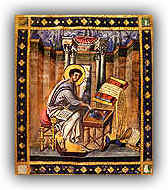 literate practices on art. Many were produced in imperial or patriarchal workshops and constitute a landmark in Byzantine art, having positively influenced the evolution of painting in the following centuries. The majority of the manuscripts, both in subject matter and style, express the return towards classical models that was typical of the Byzantine state in the age of the Macedonian Emperors. Of special interest is the patronage of Constantine Porphyrogennetos and his encouragement of classical forms.
literate practices on art. Many were produced in imperial or patriarchal workshops and constitute a landmark in Byzantine art, having positively influenced the evolution of painting in the following centuries. The majority of the manuscripts, both in subject matter and style, express the return towards classical models that was typical of the Byzantine state in the age of the Macedonian Emperors. Of special interest is the patronage of Constantine Porphyrogennetos and his encouragement of classical forms.
 Apart
from the manuscripts that will be more fully described later, one should
mention the Christian Topography of Kosmas Indikopleustes, in the Vatican
(Vat. gr. 699) and the Liturgical Homilies of Gregory of Nazianzos, in Paris (no.
510). The Codex 510 was produced for Basil I (867-886), and based on the
portraits of his family. It can be dated to around 880.
Another important manuscript is the Codex (Bible) of the Magistros Niketas,
whose full-page illustrations remind the reader of classical models and illustrate
the Prophets of the Old Testament. Manuscript no. 43 of the Stauroniketa
monastery represents a series of Gospels
decorated in classical style, and the figures of the evangelists
are reminiscent of ancient philosophers. The Theriaka of Nikander (a Greek
poet of the 2nd century BC) and the De materia medica of Dioskorides
(a Greek physician and pharmacologist of the 1st century) are two of the
most remarkable manuscripts of this period.
Apart
from the manuscripts that will be more fully described later, one should
mention the Christian Topography of Kosmas Indikopleustes, in the Vatican
(Vat. gr. 699) and the Liturgical Homilies of Gregory of Nazianzos, in Paris (no.
510). The Codex 510 was produced for Basil I (867-886), and based on the
portraits of his family. It can be dated to around 880.
Another important manuscript is the Codex (Bible) of the Magistros Niketas,
whose full-page illustrations remind the reader of classical models and illustrate
the Prophets of the Old Testament. Manuscript no. 43 of the Stauroniketa
monastery represents a series of Gospels
decorated in classical style, and the figures of the evangelists
are reminiscent of ancient philosophers. The Theriaka of Nikander (a Greek
poet of the 2nd century BC) and the De materia medica of Dioskorides
(a Greek physician and pharmacologist of the 1st century) are two of the
most remarkable manuscripts of this period.